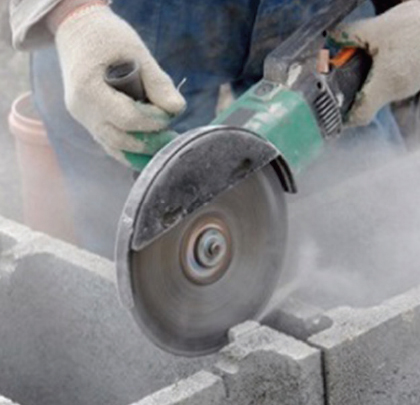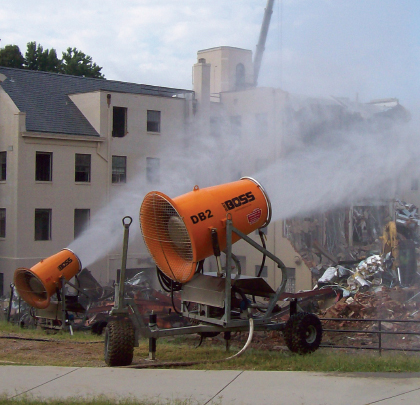In a move to help silica dust-producing operations comply with impending rule changes, a pioneer of industrial dust control is reminding companies that the Occupational Safety and Health Administration (OSHA) respirable crystalline silica (RCS) dust emissions Final Rule [OSHA §1910.1000 Respirable crystalline silica] compliance deadline is June 23, 2018. BossTek (formerly Dust Control Technology) helps operators safeguard the health of individuals by emphasizing the use of field-proven atomized misting systems to minimize dust particles, forced downtime, and potential fines.
Serving applications from concrete cutting to slag handling to demolition and recycling, workplace safety has always been a priority for BossTek. “We believe that dust control doesn’t need to come at the expense of production or profits but should support operations and deliver a return on investment,” explains CEO Edwin Peterson. “Although added regulations are always a strain on any business, compliance is an opportunity to assess current dust control efforts and improve effectiveness.”
WHY THE REGULATION?
Due to the small size, RCS of PM10 (particulate matter ≤10 microns [µm]) can penetrate the body’s natural defenses (mucous membranes, cilia, etc.), reaching deep into the lungs. Invisible to the naked eye and able to travel long distances on ambient air currents, workers are often unaware of the lingering RCS and take off protective masks, risking exposure and potentially contracting silicosis over time.
Silicosis is a chronic and incurable disease that affects millions of workers in a wide variety of industries. Without proper protection, workers with extensive exposure can experience a buildup of RCS deep in the lungs, restricting lung capacity. Silicosis can potentially lead to more harmful and life-threatening lung ailments such as pneumonia, pulmonary tuberculosis, and lung cancer.
With this in mind, not only does the OSHA Final Rule require regular monitoring by the employer, but it also sets personal exposure limits (PEL) and suggests engineering controls and particulate isolation rather than putting the entire onus of wearing uncomfortable respirators on the employees. By doing this, regulators also limit fugitive dust emissions from leaving the site line and exposing the wider public.
“The RCS regulations are touching a wide range of industries,” says Peterson. “Some operations can implement a single solution, whereas others create dust throughout the entire processes and require unique solutions at each stage.”
COMPLIANCE
Using a personal dust monitor worn by a trained employee continually monitors the amount of RCS to ensure the exposure is under the average “action level” of 25 µg/m3 (micrograms of RCS per cubic meter of air). Plants must protect workers if they have an amount of RCS dust above the PEL of 50 µg/m3, averaged over an 8-hour day. To control these levels, OSHA gives very general instructions regarding methods of compliance, advising companies to:
- Use engineering controls: Isolate dust in sealed chute systems and dust collectors, and/or using water-based atomized suppression systems.
- Provide respirators: Compliance cannot be achieved by respirators alone but should be used in areas where engineering controls cannot adequately limit exposure.
- Limit worker access to high exposure areas: Vary staff assignments throughout the day.
- Develop a written exposure control plan: Have it available along with monitoring results.
- Offer medical exams to highly exposed workers: Review the regulation for compliance details.
- Train workers on silica risks and how to limit exposures: Workers should be able to identify to OSHA inspectors the dust control supervisor and the compliance details when asked.
Non-compliance could result in fines, process disruptions, and legal action by federal or state agencies or workers. If PEL readings are at or above the permissible exposure level, plants must take action with isolation or engineered controls. And fines—even for first offences—can be steep. For example, following the construction industry deadline of June 23, 2017, some general contractors and developers could face fines of $40K to $70K.

Concrete cutting, demolition, and recycling will be among the industries affected by the new OSHA rule.
ENGINEERING CONTROLS AND ISOLATION
Engineering controls include equipment that reduces or eliminates worker exposure to RCS. To address outdoor dust emissions from a wide range of activities, including storage pile management, cutting, demolition, and recycling activities, the DustBoss® line of atomized mist cannons uses high-pressure water driven to a circular manifold at the end of a specialized cylindrical barrel with an industrial fan in the back. As the unit oscillates, the fan directs air through the cone-shaped cannon and propels millions of tiny droplets approximately the same size as the dust particles in a long cone covering an area of up to five football fields in size.
Outdoor isolation of particle emissions for stack out conveyors and chutes where the cargo stream is exposed to open air currents can be accomplished using point source suppression such as non-mechanical misting rings and spray bars. A misting ring encloses the stream in a curtain of atomized mist, preventing dust from migrating. Open air discharge resulting in dusty blowback from impact (e.g., when vehicles load into a hopper or from a conveyor discharging into a transfer chute) can be suppressed by combining rings and spray bars to create a dust barrier.
For hydrophobic materials like coal, dosing pumps attached to both the mechanical and non-mechanical units can apply dust-suppressing surfactants and crusting agents. The sprayed surfactant agents reduce the surface tension of water, improving its ability to wet surfaces and form fine droplets that reduce dust emissions.
“Compliance not only protects workers, but also protects the bottom line from downtime, fines, and lawsuits,” says Peterson. “Investing in long-lasting and field-proven equipment translates to a sensible ROI and peace of mind over the long term.”
_________________________________________________________________________
Modern Contractor Solutions, May 2018
Did you enjoy this article?
Subscribe to the FREE Digital Edition of Modern Contractor Solutions magazine.



